语用学视角下的广告语言研究——广告用语中的指示语
- 格式:ppt
- 大小:418.00 KB
- 文档页数:13
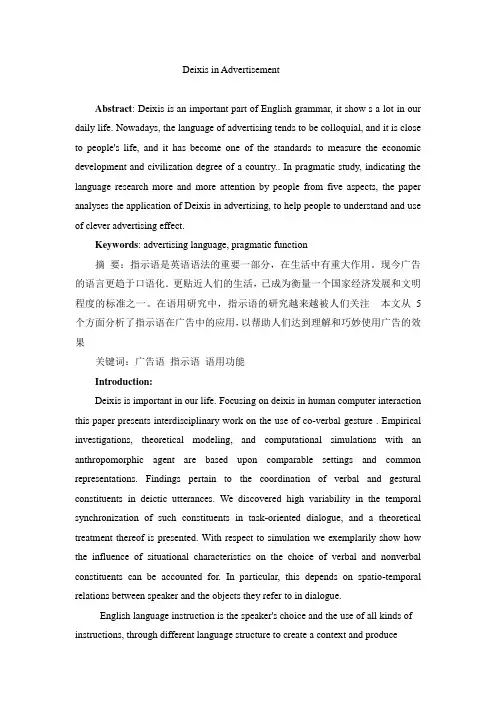
Deixis in AdvertisementAbstract: Deixis is an important part of English grammar, it show s a lot in our daily life. Nowadays, the language of advertising tends to be colloquial, and it is close to people's life, and it has become one of the standards to measure the economic development and civilization degree of a country.. In pragmatic study, indicating the language research more and more attention by people from five aspects, the paper analyses the application of Deixis in advertising, to help people to understand and use of clever advertising effect.Keywords: advertising language, pragmatic function摘要:指示语是英语语法的重要一部分,在生活中有重大作用。
现今广告的语言更趋于口语化.更贴近人们的生活,已成为衡量一个国家经济发展和文明程度的标准之一。
在语用研究中,指示语的研究越来越被人们关注本文从5个方面分析了指示语在广告中的应用,以帮助人们达到理解和巧妙使用广告的效果关键词:广告语指示语语用功能Introduction:Deixis is important in our life. Focusing on deixis in human computer interaction this paper presents interdisciplinary work on the use of co-verbal gesture . Empirical investigations, theoretical modeling, and computational simulations with an anthropomorphic agent are based upon comparable settings and common representations. Findings pertain to the coordination of verbal and gestural constituents in deictic utterances. We discovered high variability in the temporal synchronization of such constituents in task-oriented dialogue, and a theoretical treatment thereof is presented. With respect to simulation we exemplarily show how the influence of situational characteristics on the choice of verbal and nonverbal constituents can be accounted for. In particular, this depends on spatio-temporal relations between speaker and the objects they refer to in dialogue.English language instruction is the speaker's choice and the use of all kinds of instructions, through different language structure to create a context and producemeaning, to achieve the purpose of communication. There are many research abroad. English deixis including personal, spatial, temporal, and social deixis.The relationship between discourse and context is reflected by the language structure. In essence, the phenomenon of the phenomenon involves the use of language to express the characteristics of context, so it involves the expression of language, and it also involves how to understand the meaning of the discourse. In order to understand the advertising, this paper discusses the pragmatic function of the target language in advertising.I. The definition and characteristics of advertisingThe word "advertisement" derives from the Latin "advertere", which means "to arouse the attention of the public to something, and to induce a means to be used in a certain direction". At present, many scholars explain advertisements differently in the text, but the basic meaning is of the same. Advertising is a way of publicity to report the service contents and entertainment programs as, through a variety of media information on products, services and ideas such as non personal presentation and promotion. Advertising has the function of information, arouse the need to function, persuade the function, promote the action function and support the credit function. Advertising is targeted at consumers. In order to attract consumer attention, advertising coverage rate is high, strive to be brief, relatively new and strong flexibility, so that consumers never forget. In order to narrow the distance with consumers, advertising language to strengthen the use of the indicator., this paper analyzes the advertisement from the perspective of pragmatics.II. Definition and classification of indicatorDeixis is derived from the Greek language, the original meaning is to point, indicating. Indicates is some elements of the language structure to participate in the conversation, things, as well as the session time, space and other information. The implementation of instructions need to use pronouns, adverbs, pronouns, demonstratives, anaphoric tense language elements. The referential meaning or the meaning of the expression of the indicator including person, time, space, chapter,conversation, etc.. There are two kinds of methods, one is gestural usage, the other is the symbolic usage. Some of the instructions and the characteristics of the language are used together, such as the use of a finger point, a rejection of the head, the use of a color, etc.. To understand the use of the phrase, you must know what kind of language the speaker uses. The symbol type deictic words is not necessarily involved posture, gestures, and wink, , do not need to be personally on the scene, only needs to know the context knowledge.In the face-to-face communication, the system is organized with the center of the self (speaker). Deixis deictic Centers are: (1) generally the central character is speaker;(2) time center is the speaker's time; (3) central location is where a speaker speaks; (4) center discourse is the speaker’s word; (5) social center is the speaker’s the social status of the object.According to Fillmore's point of view, the dexis is divided into five categories, one is the person deixis, which is the role of the participants. Personal instructions are divided into three categories: first person, second person and third person.The second is the time deixis. The third is the place deixis, is to express position of the participants in the space position with the words. The forth is the discourse deixis, a part of a word that is used to express a word. The fifth is social deixis, is the language structure which reflects the social features of language users and relative social statusIII、Application of indicator in advertisingA. Personal deixis1.First person indicationThe first person indication are I and we, a singular and plural. determine their means, we need to think a specific context to determine their means. For example:(1)I click.I shop.Line the clothes I love.(Online shopping ads)(2)To me,the past is black and white,but the future is al—ways colorfu1.(Hennessy liquor)Here I and me closer to the distance with consumers, not only refers to the "I",but to every consumers in online shopping, together with the first sentence parallel structure use, give people left very deep impression, to convince consumers to buy thing.(3)Every time we race,you will. This is the ad title of YAMAHA electric piano. We obviously don not refer to the generation of consumers, but the seller, indicating that customers use this brand of electronic piano, there is no doubt that the beneficiary. We think there is a lot of cross phenomenon between pragmatics and social linguistics. The first person "we" can be understood as a reference in the context of the situation. In academic papers or books, "we" actually only refers to the author, does not include the reader of other people, but "we" appeared in the content or ideas with to discuss with readers in tone, suggest that the modest, thus helping to improve the contents of acceptability, identity.2.Second person instructionsSecond person instructions are mainly used to indicate the listener. In English, the second person pronoun plural form, are you. In Chinese, the second person pronoun singular and plural are same.(1)It’s your life.It’S your store.(Acme supermarket )(2)Nothing can prepare your senses for France.(Travel ads in Europe)(3) The mass of Shanghai will always be with you. (V olkswagen) It can be seen that the English ads tend to use the "you", and the Chinese advertising is preferred to use the "you", with respect to the table, which is different from the Chinese and Western culture. These ads are short and concise, the use of the word make the distance between the consumer and product closer, highlighting the advantages of the product, in order to produce the desire to buy the reader3.Third person instructionsEnglish third person deixis pronoun including "he, she, it, one and so on, but the third person pronouns only occasionally used to indicate, mainly used as reference and refers to. (1)He was bon in 1963,and he’S still lying with US today. He here refers to a kind of wine, in the sentence was given the ability to fly, it is very popular.(2)Before our designers create a car,they talk to outside expels. This car advertisement surprise readers, indicating that the car is eclectic, experts inside and outside the crystallization of the collective, to the readers left a deep impression.B temporal deixisTemporal deixis includes time noun, time indicating unit nouns, phrases and some indication of the time adverbs of time. Generally speaking, the distance is smaller, indicative expression possible way are more; and the distance are greater. Indicative expression possible way are smaller.1.Communicating every month:S82Health club every month:S82Insurance,every month :$82Trading a checkbook for a story book :Priceless (Master card ). This slogan used the "every+ non calendar time unit" approach, the formation of a pair of ratio, which highlights the value of this product.2.PLAY TODAY!( lottery America.)3.Visit Now! The Second advertising use with time indicator today, the third use the now, are called on consumers to act quickly.C Spatial deixisWhere the place is also called a direction indicator, the relative position of a person or something is to be determined by a specific person or thing as a reference point. Space indicating language refers to the place or space of people to convey information or to carry out the speech act through the word. Including the representation of the near and far refers to the demonstrative pronouns, place indicating structure (the phrase, set in the phrase, etc.), as well as the location of the adverb. For example, here,there,nearby,in this place ,in that place ,in those situations. In English. The most commonly used words indicative space including range adverb "here" and "there". The demonstrative pronouns "this" and "that", and the corresponding verb "come" and so on.1.Are You Smart Enough to Click Here?2.Enter Here3.If you’ re tired of waiting for dry Cleaning or to have shits lau nched,come to Klinke Cleane.First, and second ad language occurs in each big website, to attract consumers to sellers online store. The third the advertising language is a laundry shop. One comes up with the reader's attention, which emphasizes the interests of consumers.It can be seen that the advertising language is usually used to use some of the words, so that the reader's distance. It is conducive to trade.D. Discourse indicatorThe discourse indicator is also called a chapter, and the reference point of the chapter indicates the language of the text. An utterance or an instruction in the course of an utterance or a certain indicator of the preceding utterance. In advertising, "this" is usually used to refer to the characteristics or properties of a product.1.If your feet could dream.this is what they’d dream about.This is the ad for SPOTS SOFR shoes, and it is appropriate for the shoe.2.This is what the best people use. (cosmetic advertisements) the advertisement introduced the cosmetics are very popular, the contestants are in use, good attracted the attention of readers.E. Social deixisThere are usually two ways of expressing social instruction, one by choosing different names to express the relationship between the speaker and the speaker. In English, we use Miss, Mrs or MR to show respect or propriety; another way is limited to certain persons with a specific identity or status. In advertising, it is usually the first way.1. Beijing Le Grand Large Hotel welcome you 12. If you were slim, you evoke childhood memories! (hula hoop AD)3. For your safety, please fasten your seat belt!As we can see, in the advertising generally tend to use "you", expressing therespect of customerTo sum up, the indication language has already been quite extensive in the application of advertising language. Apporiate use of deixis, can greatly shorten the psychological distance between consumers and advertising, to achieve a resonance and synaesthesia, make the advertisement produce a striking effect, thus, it is a good way to make a good deal.Verschueren's context adaptation theory provides a new perspective for the study of context. This paper takes the use of the word of praise as an example, which is based on the theory. It is worth noting that, although the exaggeration of the sentence in language communication is reasonable common. But it does not mean that the language can be used regardless of the facts, exaggerated. Because people in the use of language is always consciously or unconsciously the constrained by the context, To some extent, the language users to do a choice, so it is necessary to grasp the central status of self, and reasonable and effective factors associated with mental world, social world and physical world do adaptation. We can reach a harmonious communication.ConclusionThe deixis is very common in life. Advertising is just one aspect of it. The deixis also has a great influence on our language learning. We discovered high variability in the temporal synchronization of such constituents in advertisement, and a theoretical treatment thereof is presented. With respect to simulation we exemplarily show how the influence of deixis on the different advertisement. Deixis will be more and more important in the near feature.References[1] Lin Yi. Analysis of verbal communication based on the theory of context adaptation. 2010.[2] Song Zhiping. Selection and adaptation of Northeast Normal University. Northeast Normal University, 2007[3]GeorgeYule.Pragmatics[M].Shanghai: Shanghai Foreign Language Education Press Agency[4]Zhaoxiong He. Pragmatics[M]. Shanghai: Shanghai foreign language education Edition. 2000.[5]Hang Gao. Pragmatics [M]. Shanghai: Shanghai Foreign Language Education Press Social. 2005.[6]Yanxi Wang.One of the main commercial English in advertising[M]. Beijing: Foreign Economic and tradeSchool Press. 2004.。
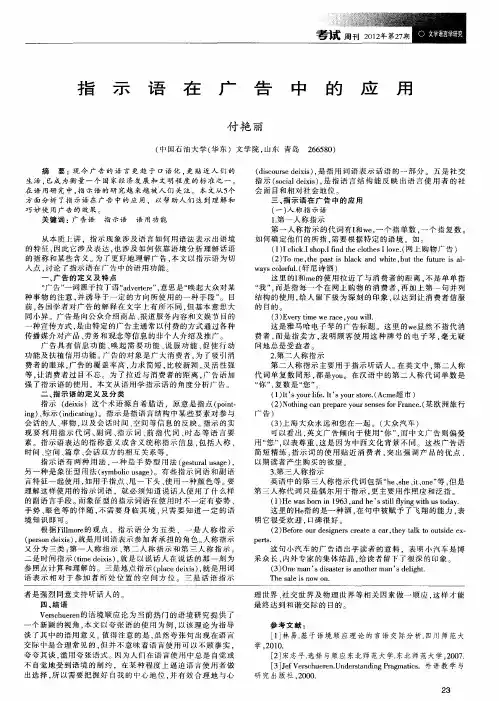
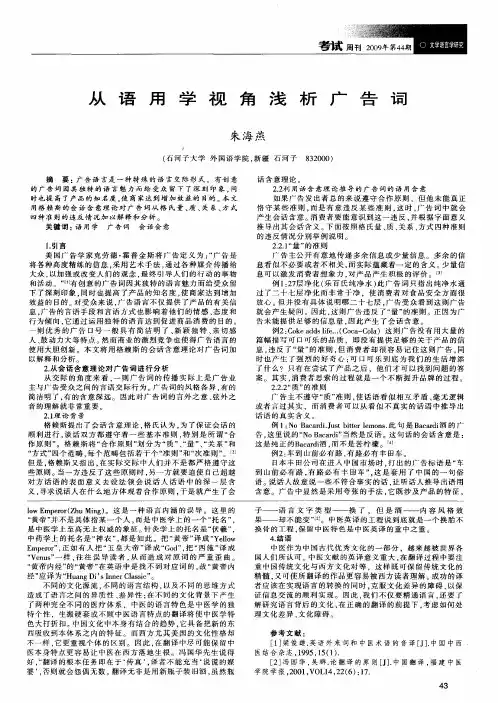
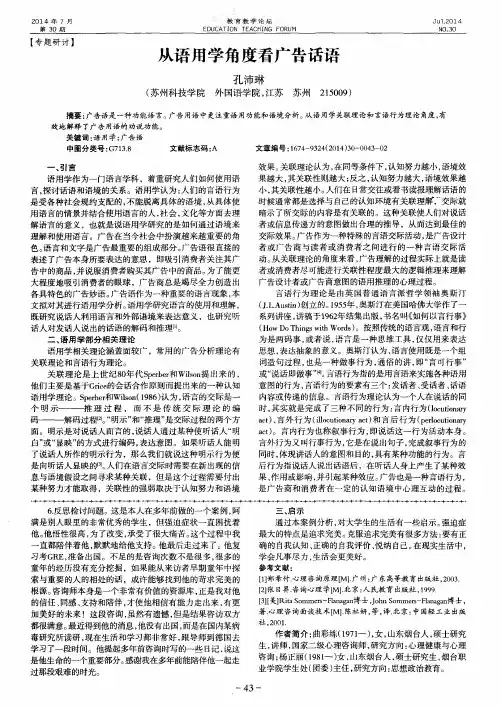

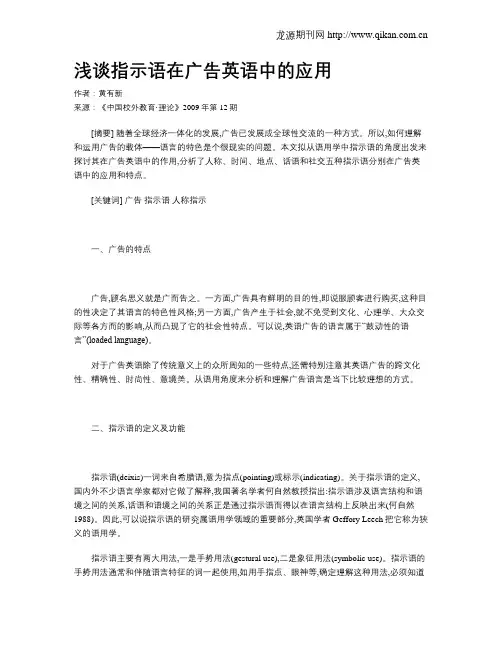
浅谈指示语在广告英语中的应用作者:黄有新来源:《中国校外教育·理论》2009年第12期[摘要] 随着全球经济一体化的发展,广告已发展成全球性交流的一种方式。
所以,如何理解和运用广告的载体——语言的特色是个很现实的问题。
本文拟从语用学中指示语的角度出发来探讨其在广告英语中的作用,分析了人称、时间、地点、话语和社交五种指示语分别在广告英语中的应用和特点。
[关键词] 广告指示语人称指示一、广告的特点广告,顾名思义就是广而告之。
一方面,广告具有鲜明的目的性,即说服顾客进行购买,这种目的性决定了其语言的特色性风格;另一方面,广告产生于社会,就不免受到文化、心理学、大众交际等各方而的影响,从而凸现了它的社会性特点。
可以说,英语广告的语言属于“鼓动性的语言”(loaded language)。
对于广告英语除了传统意义上的众所周知的一些特点,还需特别注意其英语广告的跨文化性、精确性、时尚性、意境美。
从语用角度来分析和理解广告语言是当下比较理想的方式。
二、指示语的定义及功能指示语(deixis)一词来自希腊语,意为指点(pointing)或标示(indicating)。
关于指示语的定义,国内外不少语言学家都对它做了解释,我国著名学者何自然教授指出:指示语涉及语言结构和语境之间的关系,话语和语境之间的关系正是通过指示语而得以在语言结构上反映出来(何自然1988)。
因此,可以说指示语的研究属语用学领域的重要部分,英国学者Geffory Leech把它称为狭义的语用学。
指示语主要有两大用法,一是手势用法(gestural use),二是象征用法(symbolic use)。
指示语的手势用法通常和伴随语言特征的词一起使用,如用手指点、眼神等,确定理解这种用法,必须知道说话人说话的同时使用了什么伴随语言手段,因此,手势指示词语的理解完全依靠原来的真实交际情景。
那么什么是指示词语的象征用法呢?很明显,与手势用法不同,象征型的指示词语在使用时不一定有手势、眼神等的伴随,对它们进行理解也无须重现交际的真实情景,只需了解交际活动的时间、地点、参与者和具备一定的语境知识就可以。
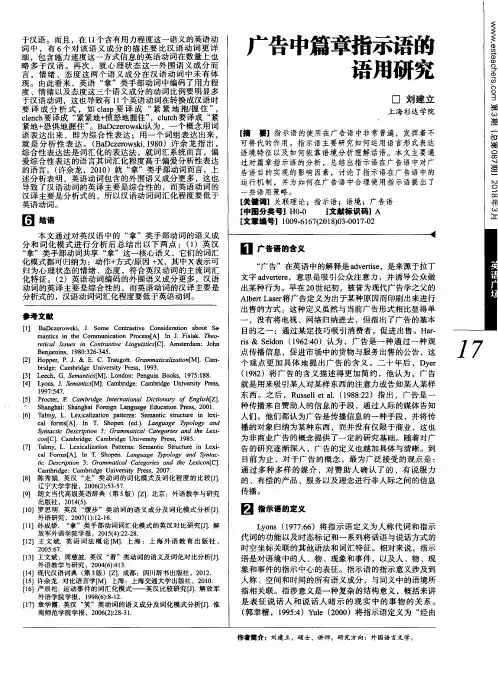

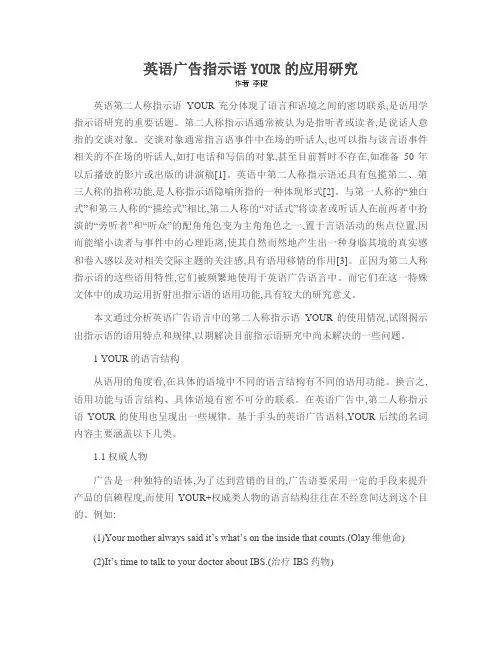
英语广告指示语YOUR的应用研究英语第二人称指示语YOUR充分体现了语言和语境之间的密切联系,是语用学指示语研究的重要话题。
第二人称指示语通常被认为是指听者或读者,是说话人意指的交谈对象。
交谈对象通常指言语事件中在场的听话人,也可以指与该言语事件相关的不在场的听话人,如打电话和写信的对象,甚至目前暂时不存在,如准备50年以后播放的影片或出版的讲演稿[1]。
英语中第二人称指示语还具有包揽第二、第三人称的指称功能,是人称指示语隐喻所指的一种体现形式[2]。
与第一人称的“独白式”和第三人称的“描绘式”相比,第二人称的“对话式”将读者或听话人在前两者中扮演的“旁听者”和“听众”的配角角色变为主角角色之一,置于言语活动的焦点位置,因而能缩小读者与事件中的心理距离,使其自然而然地产生出一种身临其境的真实感和卷入感以及对相关交际主题的关注感,具有语用移情的作用[3]。
正因为第二人称指示语的这些语用特性,它们被频繁地使用于英语广告语言中。
而它们在这一特殊文体中的成功运用折射出指示语的语用功能,具有较大的研究意义。
本文通过分析英语广告语言中的第二人称指示语YOUR的使用情况,试图揭示出指示语的语用特点和规律,以期解决目前指示语研究中尚未解决的一些问题。
1 YOUR的语言结构从语用的角度看,在具体的语境中不同的语言结构有不同的语用功能。
换言之,语用功能与语言结构、具体语境有密不可分的联系。
在英语广告中,第二人称指示语YOUR的使用也呈现出一些规律。
基于手头的英语广告语料,YOUR后续的名词内容主要涵盖以下几类。
1.1 权威人物广告是一种独特的语体,为了达到营销的目的,广告语要采用一定的手段来提升产品的信赖程度,而使用YOUR+权威类人物的语言结构往往在不经意间达到这个目的。
例如:(1)Your mother always said it’s what’s on the inside that counts.(Olay维他命)(2)It’s time to talk to your doctor about IBS.(治疗IBS药物)这里的mother和doctor代表着不同领域的权威人物:mother一般具有丰富权威的生活经验,也是能关心别人的化身,这里引用your mother的话意在说明Olay的效果很彻底;doctor具有权威的医学知识,用在这里用以说明IBS(肠道综合症)不可小觑,须及时治疗,要治疗就要买药,这样就间接推销了被广告的药物。
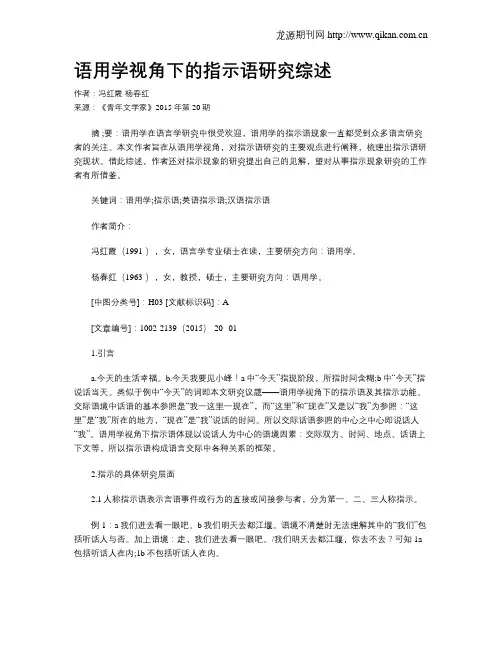
语用学视角下的指示语研究综述作者:冯红霞杨春红来源:《青年文学家》2015年第20期摘 ;要:语用学在语言学研究中很受欢迎,语用学的指示语现象一直都受到众多语言研究者的关注。
本文作者旨在从语用学视角,对指示语研究的主要观点进行阐释,梳理出指示语研究现状。
借此综述,作者还对指示现象的研究提出自己的见解,望对从事指示现象研究的工作者有所借鉴。
关键词:语用学;指示语;英语指示语;汉语指示语作者简介:冯红霞(1991-),女,语言学专业硕士在读,主要研究方向:语用学。
杨春红(1963-),女,教授,硕士,主要研究方向:语用学。
[中图分类号]:H03 [文献标识码]:A[文章编号]:1002-2139(2015)-20--011.引言a.今天的生活幸福。
b.今天我要见小峰!a中“今天”指现阶段,所指时间含糊;b中“今天”指说话当天。
类似于例中“今天”的词即本文研究议题——语用学视角下的指示语及其指示功能。
交际语境中话语的基本参照是“我一这里一现在”,而“这里”和“现在”又是以“我”为参照:“这里”是“我”所在的地方,“现在”是“我”说话的时间。
所以交际话语参照的中心之中心即说话人“我”。
语用学视角下指示语体现以说话人为中心的语境因素:交际双方、时间、地点、话语上下文等,所以指示语构成语言交际中各种关系的框架。
2.指示的具体研究层面2.1人称指示语表示言语事件或行为的直接或间接参与者,分为第一、二、三人称指示。
例1:a我们进去看一眼吧。
b我们明天去都江堰。
语境不清楚时无法理解其中的“我们”包括听话人与否。
加上语境:走,我们进去看一眼吧。
/我们明天去都江堰,你去不去?可知1a 包括听话人在内;1b不包括听话人在内。
2.2时间指示语通过话语传达信息的时间关系,以说话人的话语时间为参照。
如英语的now;汉语的昨天。
例2:今晚一过,苹果就不会卖得这么快了。
若无语境,“今天”所指不明确,编码时间、受话时间、所指时间不一致,“苹果就不会卖得快了”令人费解。

浅析指示语在广告中的应用作者:李京京来源:《青年文学家》2013年第36期摘要:随着科技和经济的发展,广告已经发展成为一种国际交流的方式。
广告是一种信息时代的社会现象,它已经走进经济、文化等方方面面,它包含许多语用功能。
指示语在广告中的应用也是引起消费者购买产品另一种方式。
通过对指示语的功能和特点的研究,它能够帮助广告商设计出更加科学合理的广告。
同时,也能使广告语言更加多样化,有助于广告话语的组织。
关键词:指示语;广告;应用作者简介:李京京(1990-),女,黑龙江省黑河人,东北林业大学外国语学院,2012级硕士研究生,英语专业,研究方向为英语语言学。
[中图分类号]: H08 [文献标识码]:A[文章编号]:1002-2139(2013)-36--01广告是我们生活中必要的一部分。
随着社会和科技的发展,人们常常通过广告来了解许多产品。
无论我们走到哪里都可以看到或听到广告。
为了设计优秀的广告,广告设计者一定要尽所有可能来使用语言的力量赢得消费者的欣赏。
总之,广告语言一定要有说服力和吸引力。
独特清新的语言可以帮助实现广告的目的。
一、广告的定义与分类广告已经在现代社会上成为一种流行活动。
广告(advertise)是源于拉丁语advertere,其意为注意、诱导、传播。
美国市场协会对广告的定义是:广告是由可确认的广告主,对其观念、商品或服务所作之任何方式付款的非人员式的陈述与推广。
广告仅从它的名字就已经暗含着在我们的生活中有着扩散效应。
因此,广告的语言也被叫做“加载的语言”。
在学术的角度,广告的分类有着不同的标准。
从媒体方面,广告可以分为报纸广告、杂志广告、电视广告和网络广告等。
从地区方面,有当地的、区域的、国家的和国际的广告之分。
从营业目的上又可以分为商业广告和非商业广告。
二、指示语定义及分类指示语(deixis)起源于希腊语,它是语用学重要课题之一。
这是因为它直接关系到语言结构与语境之间的关系。
George Yule对指示语的定义是“通过语言来指示”。
语用学之广告话语分析曾志江摘 要:本文界定了话语分析的含义,运用语用学理论中的言语行为理论、会话含义理论、合作原则来探讨语用学在广告话语分析中的作用,帮助广大消费者进一步看清广告的本质。
关键词:广告话语分析;言内行为;言外行为;言后行为;合作原则中图分类号:F123.16 文献标识码:A文章编号:CN43-1027/F(2008)10-158-01作 者:中南林业科技大学外国语学院;湖南,长沙,410004一、引言现代广告从其产生之日起,不过区区百年历史。
然而对其所进行的研究却浩如烟海,不胜枚举。
众多学者从经济学、新闻学、传播学、美学、声学、心理学等不同角度对这一新兴领域进行了细致而深入的探索,取得了较为丰硕的成果,同时也确立了广告学作为一门边缘学科和综合科学的重要地位。
广告成为现代生活的一个重要组成部分,其目的在于激发人们对事物的注意,并诱导于一定方向所使用的一种手段。
本文将运用语用学理论中的言语行为理论、会话含义理论、合作原则来探讨语用学在广告话语分析中的作用。
二、话语分析11话语分析的界定。
“话语分析”(discourse analysis)这一术语是由美国结构主义语言学家哈里斯(Z.S.Harris)在他发表于1952年美国《语言》(language)杂志第28卷的一篇题为“话语分析”的文章中首次使用的。
可自从其诞生之日起至今都一直处在形形色色,林林总总的分争当中,而我们也必须首先把“话语”(discourse)和“篇章”(text)两个概念区分开来。
一般来讲,人们认为话语是大于句子的单位,这样的理解不很象精确,因为它的范围很广,可以是词、短语、小句(包括告示、标牌、广告等),也可以是一首诗歌、一篇日记、一次对话、一场演讲、一部小说等等。
由此可见,话语结构形式、话语规则、话语模式等等都是话语分析这一新的研究领域的不同侧面。
话语分析学者由于各自不同的语言观念及理论侧重,对话语进行了不同侧面的观察和分析。
从语用学的视角浅析广告词从语用学的视角浅析广告词有创意的广告词会给受众留下深刻印象,同时也提高了产品的知名度,使商家达到增加效益的目的。
本文从语用学的视角浅析广告词,欢迎阅读了解。
摘要: 广告语言是一种特殊的语言交际形式。
有创意的广告词因其独特的语言魅力而给受众留下了深刻印象,同时也提高了产品的知名度,使商家达到增加效益的目的。
本文用格赖斯的会话含意理论对广告词从格氏量、质、关系、方式四种准则的违反情况加以解释和分析。
关键词: 语用学广告词会话会意1.引言美国广告学家克劳德霍普金斯将广告定义为:“广告是将各种高度精练的信息,采用艺术手法,通过各种媒介传播给大众,以加强或改变人们的观念,最终引导人们的行动的事物和活动。
”[1]对受众来说,广告语言不仅提供了产品的有关信息,广告的言语手段和言语方式也影响着他们的情感、态度和行为倾向,它通过运用独特的语言达到促进商品消费的目的。
一则优秀的广告口号一般具有简洁明了、新颖独特、亲切感人、鼓动力大等特点。
然而商业的激烈竞争也使得广告语言的使用大胆创新。
本文将用格赖斯的会话含意理论对广告词加以解释和分析。
2.从会话含意理论对广告词进行分析从交际的角度来看,一则广告词的传播实际上是广告业主与广告受众之间的言语交际行为。
广告词的风格各异,有的简洁明了,有的含意深远。
因此对广告词的言外之意、弦外之音的理解就非常重要。
2.1理论背景格赖斯提出了会话含意理论,格氏认为,为了保证会话的顺利进行,谈话双方都遵守着一些基本准则,特别是所谓“合作原则”。
格赖斯将“合作原则”划分为“质”、“量”、“关系”和“方式”四个范畴,每个范畴包括若干个“准则”和“次准则”。
[2]但是,格赖斯又指出,在实际交际中人们并不是都严格遵守这些原则。
当一方违反了这些原则时,另一方就要迫使自己超越对方话语的表面意义去设法领会说话人话语中的深一层含义,寻求说话人在什么地方体现着合作原则,于是就产生了会话含意理论。
语用学视角下汉语指示语言的功能研究汉语指示语言在语言交际中具有重要的功能,通过指示对象的特定信息,进一步强调和界定其存在、位置和关系等信息,从而达到沟通交流的目的。
本文从语用学角度出发,对汉语指示语言的功能进行深入研究。
一、概述指示语言是一种语言现象,它通过强调和突出语境中特定的对象或事物,引起交际双方的注意,进而实现正确理解和有效沟通的目的。
汉语指示语言一般包括“这、那、这个、那个、那边、这边”等,它们的具体含义和功能在不同的语境下会有所差异。
二、2.1 表示主体的参照在语言交际中,指示语言可以明确表达主体的参照。
比如,当一位老师在教室里说:“这里没有离开的同学吧”,这里的“这里”即表示教室这个物理空间,又可以表达教师的参照,从而使得学生们能够清晰地理解老师说话的意思。
2.2 界定时间和空间指示语言可以帮助语言交际双方界定特定的时间和空间范围,进而达到更准确的交流。
比如,在一个餐馆里点餐时,服务员问:“要这个还是那个?” 这里的指示语言“这”和“那”即代表了两种不同的菜品,使得顾客能够清晰地理解服务员的意思,进而更准确地进行点餐。
2.3 突出重要性指示语言还可以通过强调和突出特定的对象或事物,进一步加强其重要性。
比如,当一位演讲者在讲述一个故事时,他可以用指示语言“那个”来突出特定的人物或事件,使得听众能够更加关注和理解其重要性。
2.4 确定关系指示语言可以帮助语言交际双方确定特定的关系,进而更好地理解语言信息。
比如,在描述一个具体场景时,一个人可以用指示语言“这个”来表示自己所在的位置,再用“那个”来表示其他物体或者人物的位置,进而使得听者清晰地了解整个场景的布局和关系。
2.5 表示语气指示语言还可以通过语气来表达不同的含义和情感,从而进一步加强其交际效果。
比如,当一个人向另一个人解释一个问题时,他可以用指示语言来表达自己的态度和情感,如“这就是你的问题所在”、“那你不是困难重重了吗?”等。
广告语篇中指示语的特点和功能论文指示语是一种常见的广告语篇中的句式,具有一些明显的特点和功能。
本文将重点讨论指示语的特点和功能。
特点一:简洁明了指示语通常以简洁明了的方式表达,只包含核心信息,用尽可能少的词汇和句子来传达广告的主题或目的。
它们通过简洁的表达方式吸引消费者的注意力,并在短时间内传递出有力的信息。
特点二:煽动情绪指示语往往具有煽动情绪的效果。
它们通过运用诸如正面情绪(如兴奋、喜悦)或负面情绪(如恐惧、焦虑)的词汇和语气,激发消费者的情感共鸣。
这种情绪激发有助于提高广告的吸引力和影响力,促使消费者采取进一步行动。
特点三:命令性语气指示语通常使用命令性的句子结构,通过直接而强烈的表达方式来鼓励消费者采取特定的行动。
这种命令性语气有助于提高广告的说服力,使消费者更容易接受和记住广告信息。
功能一:吸引注意力指示语的简洁明了性质有助于吸引消费者的注意力。
它们利用生动形象的词汇和引人注目的语句结构,激发消费者的好奇心,并引导他们进一步关注广告内容。
功能二:传递核心信息指示语在短时间内传递出核心信息,帮助消费者快速了解产品或服务的特点和优势。
通过准确而有力地表述信息,并强调产品或服务的独特卖点,指示语能够帮助消费者形成对广告内容的清晰而深刻的印象。
功能三:鼓励行动指示语的命令性语气可以促使消费者采取特定的行动,如购买产品、参加活动或访问网站。
通过使用诸如“立即购买”、“现在参加”等词汇和短语,指示语鼓励消费者立即行动,增加广告的转化率和效果。
综上所述,指示语在广告语篇中具有简洁明了、煽动情绪、命令性语气的特点,并通过吸引注意力、传递核心信息和鼓励行动的功能,提高广告的吸引力和说服力,促使消费者采取相应的行动。
指示语作为广告语篇中的一种常见句式,具有简洁明了、煽动情绪和命令性语气等特点,同时也具备吸引注意力、传递核心信息和鼓励行动的功能。
下面将从不同角度进行深入讨论,以进一步探究指示语的特点和功能。